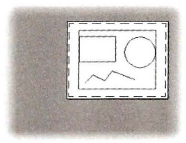Practice Exercise | Setting Viewport Scale Factor
In this practice exercise, you draw some objects in model space, then create a rectangular viewport in a selected layout tab. From the layout, you Zoom the viewport in both the model space and paper space modes. Finally, you set the viewport to a specified scale.
- Draw some geometry as shown below:
- Begin a new blank drawing based on acad.dwt.
- Create the objects in the drawing window without zooming the drawing area.
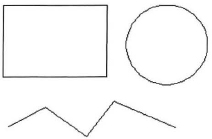
- Select the layout tab. Notice that it already has a single viewport on it. You are going to erase this and create your own viewport.
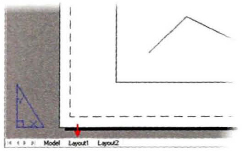
- To practice making a single viewport, first delete the one that is already there.
- With the Command line blank, click the viewport.
- On the Modify panel, click Erase.
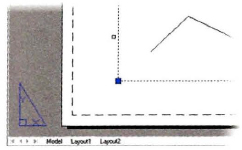
- To create a single viewport:
- At the Command line, enter -vports and press ENTER.
- Specify the corner of the viewport (1).
- Specify the opposite corner (2).
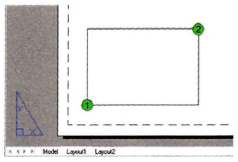
- To zoom the geometry inside the viewport:
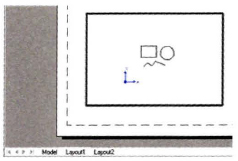
- Double-click inside the viewport.
- Notice that the viewport rectangle is bold, indicating it is active.

- Use Zoom and Pan in real time to view your drawing in the viewport
- To zoom the entire drawing layout:
- To set the viewport scale:
- Select the viewport.
- On the status bar, click Viewport Scale.

- In the list, select 1:2
- Press ESC to deselect the viewport.
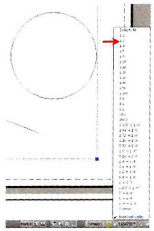
- To change the Viewport Scale and lock the viewport:
- Select the viewport.
- On the status bar, click Viewport Scale.
- In the list, select 1:4.
- On the status bar, click Lock/Unlock Viewport.

- The icon should appear locked.
- Press ESC to deselect the viewport and view the results.
Manipulating Viewports
You can manipulate viewports in many ways. If you no longer want the viewport and the data it displays, you can use the Erase command to delete it. Since it only displays geometry from model space, deleting the viewport does not delete the model space geometry. You can use the Move command to change a viewport's position on the paper. You can also use the Copy command to duplicate the viewport and its display settings to another location on the layout. To resize a viewport, use the grips at its corners.
Another way of manipulating a viewport is to freeze the display of model space layers. By controlling the display of model space layers per viewport in this way, you can display the same area of model space in different ways in each viewport. To freeze or thaw the layer in the current viewport (1), the layout viewport must be active. To make a layout viewport active, you doubleclick inside the viewport boundary. You know when a viewport is active because the boundary is highlighted, as shown in the following illustration (2), and the crosshairs change to an arrow cursor when you pass over the viewport boundary.
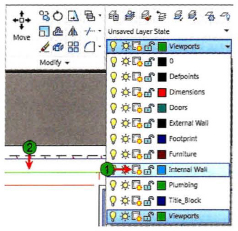
You can override layer properties in each viewport to have them appear differently in a viewport than they do in model space. For example, you may want your layout to display the walls in a different color than they are displayed in the model. Property overrides are accessed from the Layer Properties Manager when opened with a layout tab current.
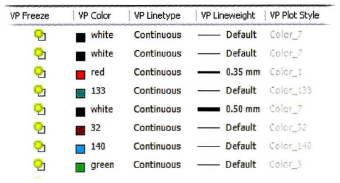
Erasing Viewports
If after creating a viewport you no longer want the viewport and the data it displays, you can use the Erase command to delete it. Since it only displays a view of the geometry from model space, deleting the viewport does not delete the geometry. You can erase, move, or copy a viewport, and you can alter the way layers are displayed in a viewport, all without losing or changing the work you have done to the original model.
Moving, Copying, and Resizing Viewports
You can use the Move command to change a viewport's position on the paper. You can also use the Copy command to duplicate the viewport and its display settings to another location on the layout. To resize a viewport, use the grips at its corners.
Altering Layers in Viewports
You can freeze the display of a layer in a selected viewport. By controlling the display of model space layers per viewport, you can display the same area of model space in different ways in each viewport. Use the freeze or thaw in current viewport option in the Layer Control list or the VP Freeze option of a selected layer in the Layer Property Manager. You must do this when the layout viewport is active. To make a layout viewport active, you double-click inside the viewport boundary. You know when a viewport is active because the boundary is highlighted, as shown in the following illustration, and the crosshairs change to an arrow cursor when you pass over the viewport boundary.
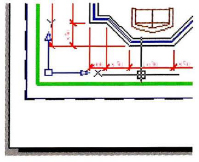
You can also override layer properties to have them appear differently in a viewport than they do in model space or other viewports. For example, you may want to display your walls at a different color in a layout than they are displayed in the model. Property overrides are accessed from the Layer Properties Manager when opened with a layout tab current. The four properties you can control are:
- VP Color
- VP Linetype
- VP Lineweight
- VP Plot Style
Procedure: Moving and Resizing a Viewport
The following steps give an overview of moving and resizing a viewport.
- Start the Move command and pick your viewport border. Press ENTER to complete the selection process.

- Pick a base point and then drag the viewport to a new position and pick your second point.
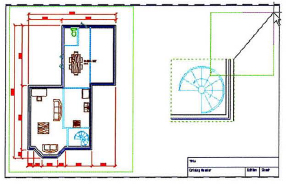
- Select your viewport border. Click a corner grip to make it hot, then click and drag to increase or decrease the size of the viewport.
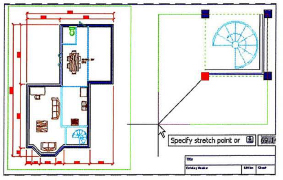
Guidelines for Manipulating Viewports
- Use grips to adjust the size of the viewport in a drawing layout.
- Copy a viewport to display the same objects then adjust the layer settings.
- Double-click inside a viewport to make it active.
- Only one viewport can be active at a time.
- Double-click outside the viewports to make the paper space layout active.
- To make multiple copies of viewports you can also use the Array command.
- Viewports can be rectangular or polygonal in shape.
- You can Clip a viewport with a polygonal shape.
- You can create a closed polyline or circle in a layout view and convert that object to a viewport.
- In AutoCAD LT®, you can create only rectangular viewports.
- Viewports created in the Model tab will display additional viewports of the drawing in the same workspace. Each viewport can display a different view of the drawing. You can switch between the viewports as you draw by clicking in the viewport first to make it active.

